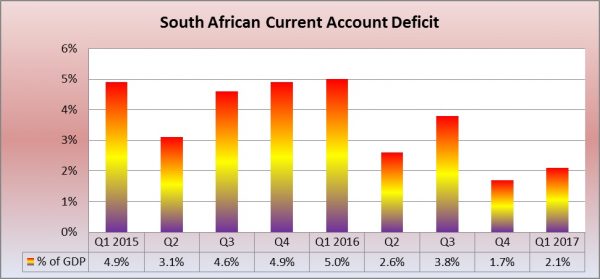

Follow us on:  
|


Workers work in new assembly production plant of China First Automotive Works (FAW) Group Corporation in Nelson Mandela Bay Municipality, South Africa [Xinhua]
The rand has weakened considerably over the past few years versus the US dollar as a current account deficit above 3 per cent is seen as unsustainable reaching a record worst level in January 2016 before recovering during the course of 2016 as the current account narrowed.
The consensus forecast of economists was for a slight widening in the current account deficit to 2.3 per cent of GDP in the first quarter.
The fact that the current account deficit has remained below 3 per cent of GDP is welcome news for South Africa’s struggling economy, as that lessens its dependency on foreign capital inflows to finance the current account deficit.
On an annual basis, the current account deficit narrowed to 3.3 per cent of GDP in 2016 from 4.4 per cent in 2015, 5.3 per cent in 2014 and 5.9 per cent in 2013.

It was only 1.5 per cent in 2010.
A current account deficit implies that the country’s domestic production is unable to keep pace with domestic demand, so South Africa’s real GDP growth rate as measured from the production side has slipped from 3.3 per cent in 2011 to 2.2 per cent in 2013, 2.5 per cent in 2012, 1.7 per cent in 2014, 1.3 per cent in 2015 and 0.3 per cent in 2016.
South Africa as a small open economy has a large exposure to its foreign trade sector with exports of goods and services accounting for 30.3 per cent of GDP in 2016, while imports have a 30.2 per cent share of GDP.
The drop in business and consumer confidence after the ratings downgrade in April will be bad for the economy in that it reduces domestic demand, but good for the current account deficit as it will lessen import demand for capital and consumer goods. The trade surpluses so far in the second quarter attest to this dynamic.
In the recession year of 2009, exports only accounted for 27.9 per cent of GDP, while imports had a 27.5 per cent share.
In the first quarter 2017 the import penetration ratio rose to 26.1 per cent from 25.7 per cent in the fourth quarter, but remained well below the levels reached in 2015 when the current account deficit was 4.4 per cent of GDP.
By Helmo Preuss in Pretoria for The BRICS Post